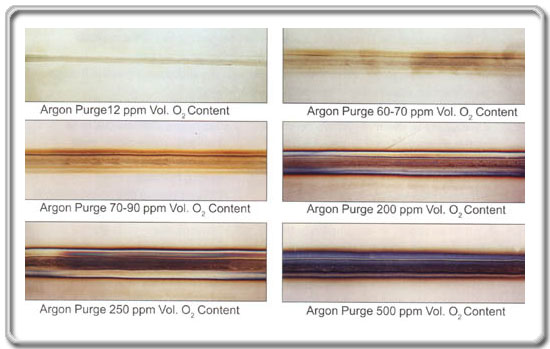Hello sk8bdr110, first off welcome to the forum. Stainless steels are susceptable to contamination/oxidation when they are unprotected above their reactive temperature. In short, if you are travelling too slowly with your weld progression and the heat input is high enough that the shielding gas is taken away from it before it has dropped below the reactive temperature that I spoke of, you will see issues with loss of the silver, gold, straw, pink, colors that will lead to the blue, black, and other less than desirable visual indications.
There has been considerable discussion of what the various colors in stainless mean and depending in many cases who you are speaking with, their opinions will vary widely as to what point there has been a compromise in mechanical and service integrity.
Personally I prefer to have the colors that are present before you reach the blue hues, yet that isn't necessarily always possible. A few tips that I will give might go like this: use an electrode extension that will allow you to keep the point of the tungsten as close to the actual weld puddle as possible without actually touching it, if you are using a gas lens, use flow rates that are slightly greater than those suggested for standard cups (try not to get too radical with your flow rates as an excess can cause turbulence that can actually induce atmosphere into the weld zone), you may want to lay back the travel angle slightly more than you have been, the more directly you point it into the joint the more you might concentrate the heat and penetration (this can be used to your advantage in some situations), sometimes more amperage and an increase in travel speed is actually better than less amperage and a slower travel speed (this may reduce the HAZ and allow for a more rapid cooling of the weld bead which can also lead to the color that you were hoping to maintain), using heat-sinks on the backside of a weld joint will also help with controlling distortion and overheating, thus helping with finished bead colors if you are trying to keep the colors that you spoke of. Experimentation and practice will likely lead you to determining what it will take for you to be satisfied with your end results. Try only changing one thing at a time and taking note of the results and don't rush into making changes after only trying something once or twice, give it a chance before trying something else. You mentioned that one of your instructors wanted you to use what might be called the "lay wire" technique, there is nothing wrong with that advice, at the same time it is not the only game in town either so try it right along with the other methods that you will likely be exposed to through other experienced welders, instructional tapes, or other sources of input. Personally I like the "lay wire" technique for pipe or open root applications and a "dab" technique for a lot of the other applications. Just a little bit for you to think about. Best regards, Allan


